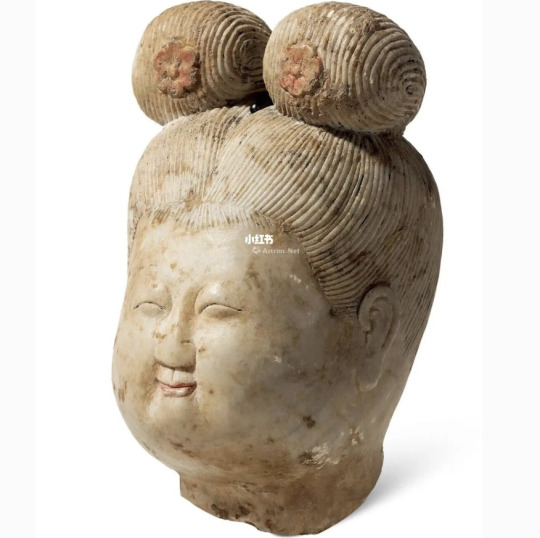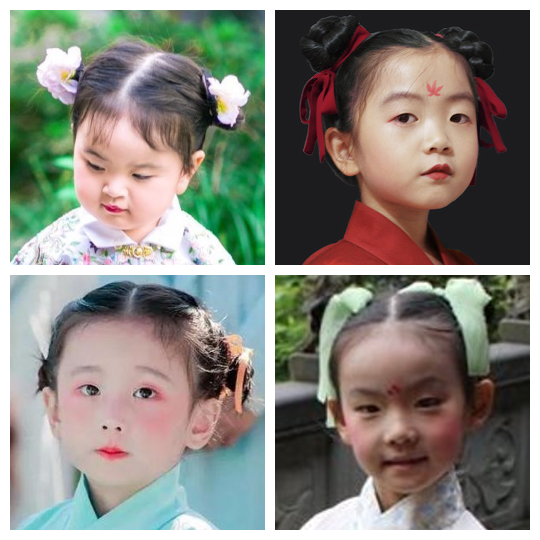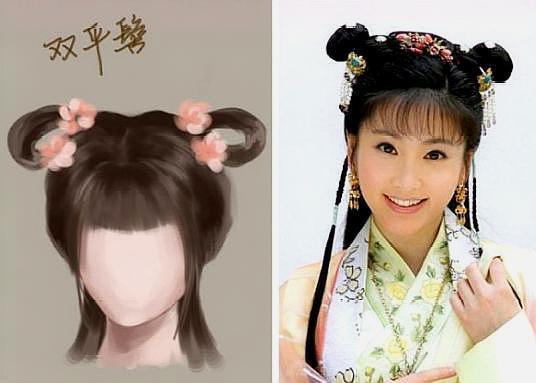#shuangyaji
Note
Space buns are very popular right now but they look like Odango hairstyle, but I heard that 牛角头 actually originated from China?? Are hairstyles an important part in the Hanfu movement.
Hi, thanks for the question, and sorry for taking ages to reply!
The double bun hairstyle you’re referring to has a long history in China, where it goes by several different names (depending on the specific style). It is most commonly know as Shuang Ya Ji/双丫髻 (lit. “double maiden bun”), so-called because it was mainly worn by girls & unmarried women. It was also worn by young boys, maids, and dancers. It is a hairstyle associated with youth. Niu Jiao Tou/牛角头 (lit. “ox horn head”) is a type of double bun hairstyle, but its shape is more angular and pointed. You can read more on the history and different types of double bun hairstyles here and here.
Below - Tang dynasty artifact depicting a maiden with a double bun hairstyle. Note the cute flower ornament on each bun! (x):

The hairstyle is still commonly worn today, mainly by young girls for festive occasions. Below - young girls in hanfu with double bun hairstyles:

As for your second question - yes, hairstyles are definitely an important part of the hanfu revival movement! After all, you can’t revive hanfu without also reviving the hairstyles to wear with it. The hanfu movement isn’t only about reviving clothing - it also involves reviving hairstyles, makeup, accessories, art, customs, etiquette, etc. And out of all of these, I’d say hairstyles get the second most amount of attention after clothing.
Hope this helps!
#hairstyles#shuangyaji#double maiden bun#niujiaotou#hanfu#hanfu movement#artifact#history#reference#ask#reply#chinese fashion#chinese clothing#chinese culture#china
398 notes
·
View notes
Note
Just for an additional question, was it true that Han women tied their hair in a braid before their coming-of-age ceremony? (Where which they had their hair tied in a knot, etc.)
Hi, thanks for the question!
No, Han women did not tie their hair in a braid before their Ji Li/笄礼, the female coming-of-age ceremony held at the age of 15 (sometimes the ceremony was held when the woman reached 20, but never later). Before the ceremony, they mainly wore their hair in double buns or loops, one on each side of the head. Here are four of some of the most common pre-Ji Li hairstyles for Han girls:
- 双丫髻/Shuang Ya Ji (Double Maiden Bun): This hairstyle symbolized youth, and was almost exclusively worn by girls who were 15 years old and younger. The style consists of two buns atop the head, one on the left and one on the right. There’s a tutorial on how to create the style here. Especially common during the Tang - Song dynasties, the Double Maiden Bun was popular in China until the early 20th century, but nowadays only worn with traditional Chinese attire:


- 丱发/Guan Fa: This hairstyle for young girls was popular from the Qin/Han dynasties to the Wei/Jin and Northern & Southern dynasties. The hairstyle consists of a middle part with buns arranged on each side of the head, after which a few strands of hair were pulled out of each bun and left to hang naturally. The hairstyle is shaped like “丱”, hence the name:

- 双平髻/Shuang Ping Ji: This hairstyle involves two buns or loops on each side of the head, again with hair hanging down the sides:

- 总角/Zong Jiao: This hairstyle, in which the hair is twisted into a bun on each side of the head, was worn by both boys and girls who had not undergone their coming-of-age ceremonies:

After undergoing their coming-of-age ceremonies and/or getting married, women would give up these youthful double bun/loop styles, instead coiling their hair into single buns fixed with jade hairpins, which were considered to be more mature and refined:

Hope this helps!
Sources: 1, 2, 3, 4, 5, 6
#hanfu#hairstyles#reference#history#tutorial#hair tutorial#art#ji li#ask#reply#ojran#double maiden bun#shuangyaji#guan fa#shuang ping ji#zong jiao#chinese culture#china
2K notes
·
View notes